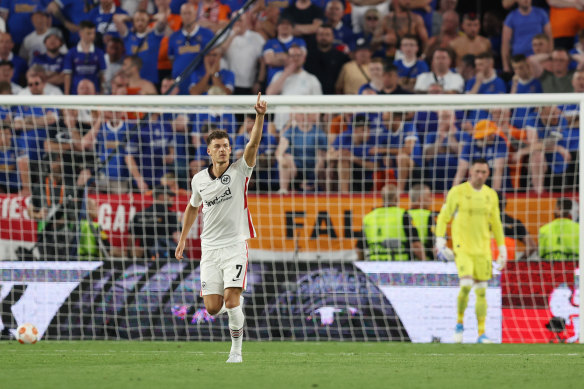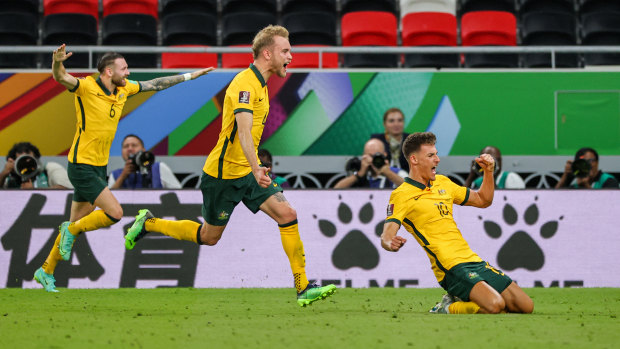Only the more ardent Australian football fans could have told you much about Ajdin Hrustic 12 months ago.
He had just finished the Dutch Eredivisie season with Groningen and hadn’t made an international appearance since a one-off cameo in 2017.
For the most part, the attacking midfielder was out of sight and out of mind. It wasn’t until a surprise move to Bundesliga club Eintracht Frankfurt in September that the first ripples began to appear.
Two weeks later, he put Asian football on notice in his first start for the Socceroos, scoring a stunning free-kick against Kuwait, the first of his three goals in the qualifying campaign for the 2022 World Cup.
For all the negativity that has surrounded the Socceroos’ journey towards Qatar, the form of Hrustic has been a source of inspiration. But, if it seems he’s come from obscurity, it is because his story began in the shadows of the Australian game.
Born in Melbourne to a Romanian mother and a Bosnian father, he abandoned the Australian player pathways programs at just 14. He tried his luck at Nottingham Forest, then at Austria Vienna before eventually settling into the famed academy of German side Schalke. Despite developing with the Gelsenkirchen giants, he never received a call from Australia’s youth teams.

Ajdin Hrustic celebrates his successful penalty during the shootout win over Rangers.Credit: Getty
Instead, it was the Football Association of Bosnia and Herzegovina that was in his ear for years. He repeatedly fended off their interest, never once relinquishing from his dream of playing for Australia, even if there had been radio silence for years.
Once he made his senior debut for Groningen in April 2017, his international career came to a head. Despite being uncapped at senior or youth level, Australia effectively had an ultimatum.
“They [Bosnia] have been calling left, right and centre in the last two weeks. They wanted me to come, even officials from the Bosnian federation contacted me and my agent, telling me their plans,” Hrustic told News Corp in 2017.
He didn’t have to say the words, but Football Australia feared it was a “use me or lose me” pitch and former Socceroos’ coach Ange Postecoglou wasn’t prepared to let another promising Australian slip from the country’s grasp. With just five club appearances, Hrustic was thrown on against Brazil at the MCG in June 2017 – a debut that future-proofed the national team’s creative midfielder stocks.

Australia’s Ajdin Hrustic (No.10) celebrates the winner against the UAE.Credit: AFP
A man who played a big role in keeping Hrustic in the green and gold was former Socceroos assistant coach Ante Milicic. Based in Croatia, he flagged the potential of the attacking midfielder and brought him into the Olyroos.
“He had a big confidence in himself,” Milicic said. “I remember, he must have told me about 50 times that he was best mates with Sadio Mane. I liked him a lot. I played him as a No.10 on the right, cutting inside on his left foot. He had a good work rate and top set pieces.”

Ajdin Hrustic has been Australia’s form player in the qualifiers.Credit: Getty
A trust in his own ability is something he’s never lacked. When Bert van Marwijk left him out of the Socceroos’ 2018 World Cup squad, Hrustic made his feelings known.
“I remember when he didn’t make the extended squad for the 2018 World Cup, he sent me a text telling me he was disappointed,” Milicic said.
When A-League club Western United were recruiting for their inaugural season, they sought advice on players from the national team. Hrustic, they were told, should be their top target. The club thought an offer of regular game time and a salary of up to $300,000 would be enough to entice him home. However, a 22-year-old Hrustic would only entertain wages normally reserved for marquees, according to sources involved in those talks.
It seemed exorbitant for a player with one cap and just 50 club appearances. But as his career progresses, it looks to have been a bargain. Eintracht paid more than $1.7 million for his services last year, a third of his current valuation.
His soaring stocks are reflective of his form - 17 international appearances in a year, starting in 12 of those, scoring three goals and providing four. He’s scored twice in 27 games in his first year at Eintracht, winning the Europa League trophy.
“His progress has really been exceptional,” former Socceroo John Aloisi said. “When he was playing in Holland, you could always see the talent he has, but he’s gone up another level. That comes with training with better players, going to a higher level and also confidence.”
He showed that courage to score a vicious free-kick against Japan in Saitama. He had no hesitation taking a penalty for Eintracht in the Europa League final shootout. Instinctively, he struck a speculative volley in the dying minutes against UAE on Wednesday to score the winner that booked Australia’s spot in the play-off against Peru on Tuesday morning.
In watching Hrustic, there are shades of Australia’s great technical midfielders of the past: Oscar Crino, Mark Bresciano and Jason Culina. Aloisi agrees his style harks back to another era, but from another country.
“When I was coming through in Italy, they would play with a lot of No.10s like him,” Aloisi said. “It’s not often seen nowadays as much. He has that quality where he can give that final ball. His technique is really good, and he can score goals from outside the box.”
Hrustic constantly demands the ball, isn’t afraid to take players on and always seeks to create an opening. That resolve and unpredictability has made him one of Australia’s best assets this campaign.
“He’s one of the players that any time of the game he can pick a pass or do something special,” Socceroos winger Matt Leckie said.
Hrustic began the campaign seemingly as a fill in. He’ll finish it as the man Peru will prioritise stopping. While some in Australia media might still be struggling with his name, the South Americans learnt it long ago.
News, results and expert analysis from the weekend of sport sent every Monday. Sign up for our Sport newsletter.